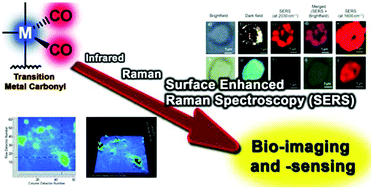Vibrational spectroscopy of metal carbonyls for bio-imaging and -sensing
Abstract
Transition metal carbonyls exhibit strong CO absorptions in the 2200–1800 cm−1 region, which is free of interference from other functional groups. This feature has led to their applications in bio-imaging and -sensing, in particular through mid-IR, Raman and more recently, surface-enhanced Raman spectroscopy (SERS). Their use in mid-IR quantitative sensing based on vibrational intensities, and chemical sensing based on frequency shifts and vibrational lifetimes, is reviewed. Their development for Raman sensing following the breakthrough in SERS highlights the potential of coupling metal carbonyls to plasmonic nanostructures as novel optical materials for SERS-based bio-imaging and -sensing.


 Please wait while we load your content...
Please wait while we load your content...